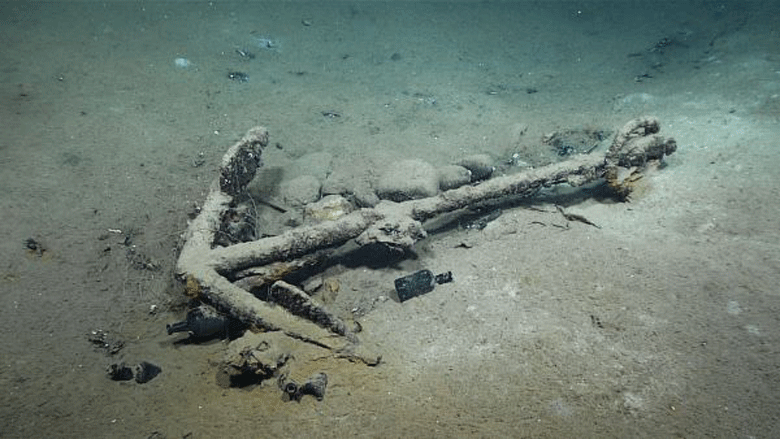NOAA and its partners have discovered the wreck of the 207-year-old whaling ship Industry on the bottom of the Gulf of Mexico. The remains of the 64-foot, two-masted wooden brig opens a window into a little-known chapter of American history when descendants of African enslaved people and Native Americans served as essential crew in one of the nation’s oldest industries.
“Black and Native American history is American history, and this critical discovery serves as an important reminder of the vast contributions black and Native Americans have made to our country,” said U.S. Deputy Secretary of Commerce Don Graves. “This 19th century whaling ship will help us learn about the lives of the black and Native American mariners and their communities, as well as the immense challenges they faced on land and at sea.”
The discovery will tell the story of how people of color succeeded as captains and crew members in the whaling industry, said NOAA Administrator Rick Spinrad. “It reflects how African Americans and Native Americans prospered in the ocean economy despite facing discrimination and other injustices.”
“If the black crewmen had tried to go ashore, they would have been jailed under local laws.”
With guidance provided via satellite connection from partner scientists on shore, a team aboard the NOAA ship Okeanos Explorer piloted a remotely operated vehicle, or ROV, to explore the seafloor at a suspected location first spotted by an energy company in 2011.
Armed with extensive research on Industry and the video from the ROV, the team of shoreside scientists has confirmed the wreck is most likely the brig Industry.
The whaling brig was built in 1815 in Westport, Mass., and hunted whales across the Atlantic Ocean, the Caribbean, and the Gulf of Mexico for 20 years. It was lost when a strong storm snapped its masts and opened its hull to the sea on May 26, 1836.
Industry primarily was hunting sperm whales more than 70 miles off the mouth of the Mississippi River. It is the only whaling ship known to have been lost in the Gulf of Mexico out of 214 whaling voyages from the 1780s to the 1870s.
While Industry eventually sank, there was some mystery about what happened to the crew. Thanks to new research by Robin Winters, a librarian at the Westport Free Public Library, the crew’s fate is finally clear. Winters tracked down a June 17, 1836 article in the Nantucket Inquirer and Mirror that reported the crew of Industry was picked up at sea by another Westport whaling ship, Elizabeth, and crewmen were returned safely to Westport.
“This was so fortunate for the men onboard,” said James Delgado of the Bureau of Ocean Energy Management (BOEM), who worked closely with Winters and several other local historians to confirm the identity of Industry. “If the black crewmen had tried to go ashore, they would have been jailed under local laws. And if they could not pay for their keep while in prison, they would have been sold into slavery.”
While the crew list for the last voyage of Industry disappeared when the ship sank, lists of crews from previous voyages describe crew members and officers as including black, Native American, white, and multiracial people.
The brig is connected to the life of Paul Cuffe, a mariner and entrepreneur whose father was a freed slave and mother was a Wampanoag Indian. Cuffe started whaling as a teenager and rose to become a successful ship builder, merchant, abolitionist, philanthropist, founder of an integrated public school, and among the leaders of a project to settle freed black people in a new colony in Africa.
His son William was a navigator on Industry and his son-in-law Pardon Cook was an officer on the brig and believed to have made the most whaling voyages of any black person in American history.
“The news of this discovery is exciting, as it allows us to explore the early relationships of the men who worked on these ships, which is a lesson for us today as we deal with diversity, equity, and inclusion in the workplace.” said Carl Cruz, a New Bedford-based historian and a descendent of the family of Paul Cuffe.
Though searchers had a strong hunch about the identity of the whale ship prior to NOAA’s ROV dive, they needed a more thorough look and the expert documentation that NOAA could provide. ROV pilots from the Global Foundation for Ocean Exploration captured high-resolution video to fully document the wreck site found 6,000 feet below the Gulf’s surface.
The ROV hovered over the telltale tryworks, a cast iron stove with two large kettles used to render whale blubber into oil. The NOAA team confirmed the shipwreck’s measurements matched those of Industry in historic documents and determined that the location of the shipwreck, 72 nautical miles from the last recorded location off the mouth of the Mississippi River, could be attributed to the still-floating ship within the Gulf of Mexico’s Loop Current.
“That there were so few artifacts on board was another big piece of evidence it was Industry,” said Scott Sorset of BOEM. “We knew it was salvaged before it sank.”
A whaling ship from the tight-knit Massachusetts community of whalers had visited the sinking Industry and removed 230 barrels of whale oil, parts of the rigging, and one of the four anchors before it sank.





